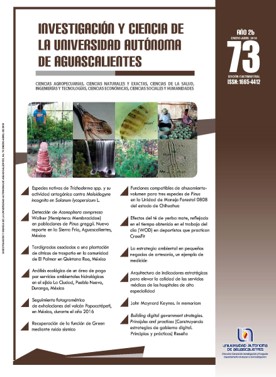Environmental strategy in handcraft small businesses, an example of measurement
DOI:
https://doi.org/10.33064/iycuaa201873209Keywords:
environmental strategy, small business, handcrafts, MexicoAbstract
This paper details a specific procedure to conceptualize and measure environmental strategy of handcraft businesses. The conceptualization and operationalization is studied from the perception of the artisan to the operating procedure of a variable. As a result of the process, the statistical validity of the study is presented using an exploratory factorial analysis, and the environmental strategy variable is explained with four factors with a reliability on the scale of .88 according to Cronbach's alpha.
Downloads
References
Aguilar, L. (13 de marzo de 2015). En peligro de extinción, artesanías de palma. Noticias Voz e Imagen [Portal oficial]. Recuperado de http://old.nvinoticias.com/oaxaca/general/laboral/267917-peligro-extincion-artesanias-palma
Aragón-Correa, J. A., Hurtado-Torres, N., Sharma, S., & García-Morales, V. J. (2008). Environmental strategy and performance in small firms: A resource-based perspective. Journal of Environmental Management, 86(1), 88-103.
Araya, U. (2003). Análisis comparativo de las necesidades ambientales de las PyME en Chile, Colombia y México. En CEPAL-ONU (Ed. de la serie), Serie Medio ambiente: 74. Santiago de Chile: CEPAL-ONU. Recuperado de http://repositorio.cepal.org/handle/11362/5775
Čater, T., Prašnikar, J., & Čater, B. (2009). Environmental strategies and their motives and results in Slovenian business practice. Economic and Business Review, 11(1), 55-74.
Chantiri, P. J. N., Azamar, A. R. A., Galván, R. R., & Lozada, H. M. A. (2003). Niveles de plomo en mujeres y niños alfareros. Revista Médica de la Universidad Veracruzana, 3(1), 16-22.
Chen, Y., Tang, G., Jin, J., Li, J., & Paille, P. (2015). Linking market orientation and environmental performance: The influence of environmental strategy, employee’s environmental involment, and environmental product quality. Journal of Business Ethics, 127(2), 479-500.
Darnall, N., Henriques, I., & Sadorsky, P. (2010). Adopting proactive environmental strategy: The influence of stakeholders and firm size. Journal of Management Studies, 47(6), 1072-1094.
Dasgupta, S., Hettige, H., & Wheeler, D. (2000). What improves environmental performance? Evidence form Mexican Industry. Journal of Environmental Economics and Management, 39(1), 39-66.
Durham, D. E., & Littrell, M. A. (2000). Performance factors of Peace Corps handicraft enterprises as indicators of income generation and sustainability. Clothing and Textiles Research Journal, 18(4), 260-272.
Fillis, I. (2002). Nurturing creative behaviour in the craft sector. Irish Marketing Review, 15(1), 38-48.
Hart, S. L. (1995). A natural-resource-based view of the firm. The Academy of Management Review, 20(4), 986-1014.
Hernández-Girón, J. P., & Domínguez-Hernández, M. L. (2003). Estrategias de mercadotecnia y los negocios de mezcal. Convergencia, 10(31), 187-203.
Hernández-Girón, J. P., Domínguez-Hernández, M. L., & Caballero-Caballero, M. (2007). Factores de innovación en negocios de artesanía de México. Gestión y Política Pública, 16(2), 353-379.
Hillary, R. (1999). Evaluation of study reports on the barriers, opportunities and drivers for small and medium size enterprises in the adoption of environmental management systems. Great Britain: Department of Trade and Industry, Envrionment Directorate.
Hillary, R. (2000). Small and medium-sized enterprises and the environment: Business imperatives. Sheffield, UK: Greenleaf Publishing.
Instituto Nacional de Salud. (2000). Encuesta Nacional de Salud. Recuperado de https://www.insp.mx/
Journeault, M., De Rongé, Y., & Henri, J. F. (2016). Level of ecocontrol and competitive environmental strategy. The British Accounting Review, 48(1), 316-340.
McKeiver, C., & Gadenne, D. (2005). Environmental management systems in small and medium businesses. International Small Business Journal, 23(5), 513-537.
Pirela de Faría, L. C. (2010). Liderazgo y cultura organizacional en instituciones de Educación Básica. Revista Venezolana de Gerencia, 15(51), 486-503.
Posada García, M. (20 de diciembre de 2004). La piratería ayuda a la gente a sentirse menos pobre. La Jornada. Recuperado de http://www.jornada.unam.mx/2004/12/20/016n1eco.php
Sales Heredia, F. J. (Comp.). (2013). Las artesanías en México. Situación actual y retos. México: Centro de Estudios Sociales y de Opinión Pública.
Sánchez-Medina, P. S. (2012). La administración ambiental en México: Importancia, reflexiones, y prácticas desde el sector artesanal. Alemania: Editorial Académica Española.
__________, & Díaz-Pichardo, R. (2017). Environmental pressure and quality practices in artisanal family businesses: The mediator role of environmental values. Journal of Cleaner Production, 143, 145-158.
Sánchez-Medina, P. S., Díaz-Pichardo, R., Bautista-Cruz, A., & Toledo-López, A. (2015). Environmental compliance and economic and environmental performance: Evidence from handicrafts small businesses in Mexico. Journal of Business Ethics, 126(3), 381-393.
Sánchez-Medina, P. S., Toledo-López, A., Bautista-Cruz, A., & Regino-Maldonado, J. (2014). Valores ambientales y su efecto mediador entre características demográficas y resultados empresariales. Revista Venezolana de Gerencia, 19(67), 435-455.
Sharma, S. (2001). Different strokes: Regulatory styles and environmental strategy in the North-American oil and gas industry. Business Strategy and the Environment, 10(6), 344-364.
__________, & Vredenburg, H. (1998). Proactive corporate environmental strategy and the development of competitively valuable organizational capabilities. Strategic Management Journal, 19, 729-753.
Velásquez, L. I. (2 de octubre de 2015). Arte Oaxaqueño, el más antiguo. Noticias Voz e Imagen [Portal oficial]. Recuperado de http://old.nvinoticias.com/oaxaca/general/tradiciones/261962-arte-oaxaqueno-mas-antiguo
Walls, J. L., Phan, P. H., & Berrone, P. (2011). Measuring environmental strategy: Construct, development, reliability, and validity. Business & Society, 50(1), 71-115.
Downloads
Published
How to Cite
License
Las obras publicadas en versión electrónica de la revista están bajo la licencia Creative Commons Atribución-NoComercial-CompartirIgual 4.0 Internacional (CC BY-NC-SA 4.0)









